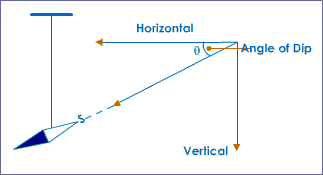Are you aware that the earth is also a magnet? Did that surprise you? How do you think then that the suspended bar magnet always points in the north-south direction? This is the concept of the Earth’s Magnetism that we are going to discuss in this chapter. It is really interesting to study and analyze this concept of earth’s magnetism.
Suggested Videos
Earth’s Magnetism
The reason, why a bar magnet points in the north-south direction, is because of the influence of earth’s gigantic magnetic field. It is believed that the electric currents circulating from earth’s core to space give rise to the earth’s magnetic field.
Browse more Topics under Magnetism And Matter
- Magnetic Properties of Materials
- Magnets and Its Properties
- Magnetisation and Magnetic Intensity
- Permanent Magnets and Electromagnets
- The Bar Magnet
This magnetic field saves the earth from the solar wind that could cause the ozone layer of the earth to strip away. The SI unit of the earth’s magnetic field is Tesla.

Theory of Earth’s Magnetism
There is no concrete reason for the cause of the earth’s magnetism. However, there are a few theories that revolve around it. Some of the theories are mentioned below:
- The Dynamo Effect: The outer core of the earth has molten Iron and other heavy elements in liquid form. The inner core solidifies under the influence of gravity. Therefore, the motion of metallic fluids in the outer core of the earth causes an electric current. Thus, the earth gets its own magnetic field lines.
- Ionization of the Outer Layers: This theory tells us that the rotation of the earth in its own axis produces strong electric current due to the ionization of the outer layers of earth. This produces magnetism due to the movement of the ions. However, the magnetic field will be very weak. The Dynamo Effect is the more acceptable theory.

Components of Earth’s Magnetic Field
Near the surface of Earth, the magnetic field of the planet can be resolved in different directions. These are the components that are responsible for the magnitude and direction of the magnetic field of the earth at a given location:
- Magnetic Declination
- Horizontal Component of Earth’s Magnetic Field
- The angle of Dip or Magnetic Inclination
Magnetic Declination
When a magnetic needle is suspended freely in the air, it always points in the north-south direction free form all other attracting forces. This is known as Magnetic Meridian.
Magnetic Declination is defined as the angle made by the Magnetic meridian with the geographic meridian. Here geographic meridian is defined as the plane passing through the north and south poles of the earth.
The Angle of Dip or Magnetic Inclination
Take a magnetic needle and suspend it freely so that it can rotate about a horizontal axis as shown in the diagram below:
 The angle of dip or magnetic inclination
The angle of dip or magnetic inclination
The angle that the north pole of the needle makes with the horizontal axis is known as the Angle of Dip or Magnetic Inclination.
The Formula for Earth’s Magnetic Field
The magnetic intensity of the earth’s magnetic field makes an angle known as Angle of Dip (δ) with the horizontal axis. We can separate the intensity of the earth’s magnetic field into two components:
- Horizontal Component(H)
- Vertical Component(v)

There are times when these elements undergo regular or irregular changes at all places on earth. Why does this happen? Following are some of the important variations of the elements.
Variations in Earth’s Magnetic Field
- Secular Variation: The magnetic axis undergoes a periodic change because of its spin around its own axis from east to west. The time cycle of this variation is 960 years.
- Eleven-year Sunspot Cycle: Once in every eleven years, the earth faces the sunspot which is a region of the strong magnetic field. Thus the magnetic activity of the earth is very much influenced by this variation.
- Daily and Annual Variation: The ultraviolet rays from the sun ionize the earth’s atmosphere. As a result of which the current is generated which further produces the magnetic field. This is the result of daily and annual variations.
- Lunar Variations: Apart from the sun, the moon also influences the magnetic activity of earth. Due to the tidal motions of the earth’s ionized layer during a lunar eclipse, there is variation in earth’s magnetic field. This variation is the Lunar Variation.
- Irregular and Aperiodic Variation: During a particular period of time when the solar activity of the sun is more active, the radiations from the sun ionize the atmosphere of the earth. This causes current when the earth revolves around its own axis resulting in the magnetic field.
Solved Example For You
Q: Why the earth has a magnetic field?
Answer: There are various theories suggesting the reason behind earth’s magnetic field. However, the two most considered theories are:
- The current generated due to the motion of liquids inside the earth’s core.
- The current generated due to the movement of the ionized particle of earth’s atmosphere when the earth rotates around its own axis.






Leave a Reply